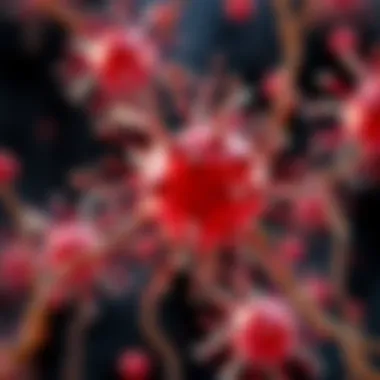Understanding Prostate Cancer Development Factors


Intro
Prostate cancer stands as one of the most perplexing challenges within the field of oncology. Men across the globe face the specter of this disease, making it vital to comprehend the underlying mechanisms that propel its development. The factors surrounding prostate cancer are multifaceted—ranging from biological forces at play within cells, to environmental influences and genetic predispositions. This article aims to dissect these layers, peeling back the intricacies that characterize how prostate cancer takes root in the body.
The interplay of hormones also plays a pivotal role, particularly testosterone, which has been shown to affect cellular processes in the prostate gland. Beyond hormonal influence, lifestyle choices—from diet to physical activity—can either mitigate or exacerbate one’s risk of developing this condition. This article will examine recent findings that provide deeper insights into these factors, presenting a well-rounded view of current research trends and ongoing investigations in this arena.
By navigating this landscape, readers will gain an understanding not only of the risk factors but also of the cellular mechanisms that signal the onset of disease.
Research Background
Overview of the scientific problem addressed
The global burden of prostate cancer is alarming, with millions diagnosed annually. It is the second most common cancer among men. However, its etiology remains complicated. Despite advances in medicine, deciphering the precise biological, environmental, and genetic factors remains a significant task for researchers and clinicians alike. Many studies have scrutinized the role of lifestyle choices and genetic markers, yet a unified theory that encompasses all contributing elements is still elusive.
Historical context and previous studies
Historically, research into prostate cancer took root in the early 20th century. Initially regarded as a neglected concern within the medical community, increased awareness led to ground-breaking studies illustrating the connection between age, race, and genetic factors, marking the early steps toward understanding this malignancy. Researchers like Dr. R. Michael C. Huggins and Dr. Charles B. Wilson laid the groundwork for hormonal therapy, which would later become a standard treatment approach. As we moved into the 21st century, advancements in genomics have sharpened the focus on potential biomarkers that could one day offer predictive capability for early diagnosis. Yet, each new study often leaves more questions than answers.
Recent investigations have brought to light new genetic mutations and specific environmental exposures that may elevate risk, such as certain dietary habits rich in specific fats and their correlation to aggressive forms of the disease. While organizations like the American Cancer Society actively collate research, each new finding often complicates the existing landscape rather than clarifying it—highlighting the complexity of prostate cancer’s origins.
Findings and Discussion
Key results of the research
Recent studies have underlined the significance of several key areas: the role of inflammation in the prostate, genetic mutations linked to hormone receptors, and the effect of diet on cancer progression. For example, a study by the National Institutes of Health discovered that men who consumed a diet high in dairy might face higher risks for developing aggressive forms of prostate cancer. This correlation paves the way for further dialogue regarding how dietary interventions could potentially alter risk profiles.
Another vital area of current research involves the genetic underpinnings of the disease. Investigators are closely watching mutations in genes like BRCA1 and BRCA2, which are typically associated with breast cancer but are also proving relevant in prostate cancer risk.
"It is increasingly evident that prostate cancer is not a singular disease but a collection of distinct entities influenced by a myriad of factors."
Interpretation of the findings
Considering these findings, it becomes apparent that understanding prostate cancer is akin to piecing together a complex puzzle. Each new insight builds upon earlier research, contributing to a broader understanding of the disease's etiology. The repetition of dietary studies highlights an urgent need to shift not just the narrative of risk but of prevention as well. As scientists continue to investigate how these factors synergize, the hope is to cultivate preventive strategies that could benefit individuals at risk.
In summary, understanding prostate cancer involves navigating through a web of multifaceted contributors. The ongoing research efforts provide a glimpse into this enigmatic disease and hold the promise of innovative treatment modalities. As the scientific community continues its quest for clarity, knowledge about hormonal influences, genetic predispositions, and the roll of lifestyle becomes paramount in the fight against prostate cancer.
Prolusion to Prostate Cancer
Prostate cancer is a prevalent health issue, particularly among men over the age of 50. Understanding this illness is pivotal not only for healthcare professionals but also for patients and their families. Given its complexity and the significance it holds in society, diving deep into the mechanisms that underpin prostate cancer development can shine a light on potential preventative measures and treatment options.
Definition and Prevalence
Prostate cancer begins in the prostate gland, which is located below the bladder and surrounds the urethra. It's typically characterized by the uncontrolled growth of cells, forming tumors that can spread to other areas of the body if left unchecked. Statistics reveal alarming prevalence; approximately 1 in 8 men will be diagnosed with prostate cancer within their lifetime. It accounts for a significant portion of cancer cases in men, second only to skin cancer in many western countries.
Research highlights that unique geographical, ethnic, and lifestyle factors contribute to these statistics. For instance, men of African descent have higher incidence rates compared to their European or Asian counterparts. This suggests that various biological, environmental, and social variables might be at play, influencing the cancer's development.
Importance of Understanding Prostate Cancer
Understanding prostate cancer is not merely an academic exercise; it's a crucial endeavor that affects treatment outcomes and quality of life for countless individuals. Knowledge about the biological mechanisms, genetic predispositions, and lifestyle influences can empower patients and physicians alike. With improved understanding, proactive measures can be taken, such as informed screening practices and tailored therapeutic interventions.
Moreover, raising awareness can help dismantle the stigma surrounding men's health issues, encouraging more men to seek regular check-ups and screenings. This fosters early detection, which is instrumental in managing the disease effectively.
Knowledge is power. The more we understand prostate cancer, the better equipped we are to fight it.
Biological Mechanisms of Prostate Cancer
Examining the biological mechanisms that underlie prostate cancer is key to understand how this disease develops and progresses. An appreciation of these processes helps researchers and healthcare professionals develop more effective diagnostic and treatment strategies. Distinct biological factors, including cellular behavior, hormonal interactions, and molecular changes, all contribute to the transition from normal prostate tissue to cancerous structures. By breaking down these complex mechanisms into manageable segments, we can shed light on the factors that increase risk and influence the severity of this cancer.
Cellular Proliferation
Cellular proliferation is the process by which cells divide and multiply. This fundamental mechanism is usually tightly regulated through various signaling pathways and checkpoints. When this regulation falters, cells can start dividing uncontrollably, leading to the formation of tumors. In prostate cancer, this runaway proliferation is often linked to mutations in critical genes that control cell cycle progression. For instance, alterations in the TP53 gene can remove crucial barriers that prevent excessive cell division.
Moreover, the microenvironment around prostate cells also plays a significant role. Growth factors, cytokines, and extracellular matrix components can either promote or hinder cell proliferation. Identifying how these factors interact with mutated genes could yield insights for therapeutic targets.
Apoptosis and Cancer Progression


Apoptosis, or programmed cell death, is a crucial process that ensures the elimination of damaged or unnecessary cells. An effective balance of cell proliferation and apoptosis is essential for maintaining healthy tissue. However, in prostate cancer, this balance is often disrupted. When cancer cells evade apoptosis, they not only survive longer but also gain a competitive advantage, allowing them to proliferate and metastasize.
The mechanism behind this evasion can be traced to alterations in apoptotic pathways. For example, overexpression of anti-apoptotic proteins like BCL-2 has been observed in many prostate cancer cases. As these proteins inhibit the cell death process, they contribute to the accumulation of cancerous cells. This characteristic also underscores the cancer’s resilience, making it a formidable opponent in treatment scenarios.
Role of Hormones
The role hormones play in prostate cancer development is profound and multifaceted. Hormones, particularly androgens like testosterone, are central to the growth and maintenance of prostate tissue. Interestingly, while testosterone is essential for normal prostate function, an imbalance can pave the way for cancerous changes.
Testosterone Influence
Testosterone influences various cellular processes in the prostate, from growth to differentiation. It operates through the androgen receptor, a critical player in mediating the effects of male hormones. When testosterone levels are elevated or when prostate cells become overly responsive to testosterone, it can promote abnormal cell growth and tumor formation. This duality makes testosterone a double-edged sword in prostate cancer. While it supports normal prostate health, excess levels or uncontrolled responses can lead to cancer development.
In terms of treatment, managing testosterone levels has become a popular approach, especially in advanced cases. Hormone therapy aims to lower testosterone levels or block its effects, thus slowing the growth of cancer cells.
Estrogen and Prostate Cancer
While testosterone has received much attention, estrogen also plays a role in prostate cancer, albeit in a less direct fashion. Estrogen's effects on prostate tissue are complex. It participates in regulatory pathways that can influence cancer progression. Increased levels of estrogen have been associated with more aggressive forms of prostate cancer.
Moreover, research suggests that estrogen might affect how prostate cancer cells respond to therapies, making it a parameter to consider in treatment plans. While it’s less prominent than testosterone, understanding estrogen’s role can enrich the picture of prostate cancer biology.
Understanding these hormonal interactions is crucial for devising effective risk stratification and treatment plans.
In summary, the biological mechanisms driving prostate cancer encompass a web of processes that involve cellular growth, death, and hormonal influences. Each layer of complexity adds depth to our understanding and highlights the critical interplay between genetics and environment. Continued research into these areas will be instrumental in developing more effective prevention and treatment strategies for this prevalent disease.
Genetic Factors in Prostate Cancer
The investigation of genetic factors in prostate cancer is fundamental to comprehending how this disease develops and progresses. Genetic predisposition plays a vital role in determining the susceptibility of individuals to prostate cancer, making it essential to probe into the hereditary and somatic mutations that contribute to the disease. Understanding these genetic underpinnings allows for better risk assessment, targeted screening measures, and potentially tailored therapies that could improve patient outcomes.
Inherited Genetic Mutations
BRCA2 and Prostate Cancer
One of the key players in the realm of inherited genetic mutations is the BRCA2 gene. This gene, well-known for its association with breast and ovarian cancer in women, has also garnered attention for its implications in prostate cancer. Men carrying mutations in the BRCA2 gene are at a heightened risk of developing aggressive forms of prostate cancer. It’s noteworthy that this genetic link underscores not just the familial trend of cancer but also the biological underpinnings that fuel its progression.
The significance of BRCA2 in the context of prostate cancer lies in its role in DNA repair; when this gene is mutated, the body’s ability to fix DNA breaks is impaired, leading to genomic instability. This instability can contribute to both the initiation and advancement of cancer. The advantage of recognizing BRCA2 mutations in patients is that it can guide clinical decision-making, including considerations for surveillance practices and treatment options, such as the possible use of PARP inhibitors, which are becoming increasingly relevant in the management of prostate cancer.
Other Genetic Markers
Beyond BRCA2, there are other genetic markers that merit attention, particularly with their predictive value in prostate cancer risk. One such marker is the HOXB13 gene, which has been implicated in hereditary prostate cancer cases. Notably, G84E, a specific mutation within HOXB13, has been associated with a significantly increased risk of developing prostate cancer among men of European descent.
Other markers, such as ATM, CHEK2, and TP53, also play roles in prostate cancer susceptibility but vary in their prevalence and impact. These markers offer a litany of insights, revealing unique pathways through which prostate cancer may develop, and presenting pathways for early intervention strategies.
However, the challenge with these genetic markers lies in their varying expressiveness within different populations. This can lead to discrepancies in risk assessment and the need for broader studies that encompass diverse demographic backgrounds. Therefore, while these markers provide valuable information, their application in clinical settings necessitates a nuanced understanding of their implications across different patient groups.
Somatic Mutations
Somatic mutations, unlike inherited genetic mutations, occur after conception and are acquired by individual cells throughout a person's life. These mutations can result from various factors, including environmental exposures or lifestyle choices. In prostate cancer, particular interest is focused on the mutations found in genes like PIK3CA, TP53, and KRAS.
These mutations often contribute to tumor aggressiveness and can inform treatment decisions. For instance, aberrations in genes linked to the PI3K/AKT/mTOR pathway are prevalent in advanced prostate cancer and may provide targets for emerging therapies. The knowledge of somatic mutations also lays a foundation for personalized medicine approaches, wherein treatments can be tailored based on the unique genetic makeup of an individual’s tumor.
Genetic Screening and Risk Assessment
Incorporating genetic screening into routine prostate cancer assessment can be transformative. It can empower high-risk individuals to engage in proactive monitoring and lifestyle adjustments aimed at reducing their risk. Genetic tests are now accessible, enabling an evaluation of inherited mutations, which can lead to early interventions or increased vigilance in terms of regular screenings.
Such assessments also present an opportunity to educate patients about their genetic risks, potentially fostering lifestyle changes or supportive measures that could mitigate their risk of developing prostate cancer. As the field continues to evolve, integrating genetic insights into standard practice not affects personal health outcomes but holds promise for public health initiatives aimed at addressing the broader impact of prostate cancer in society.
"Understanding genetic factors in prostate cancer not only illuminates the biology of the disease but also paves the way for more personalized approaches in screening and treatment."
The continuous advancements in genetic research will further unlock the mysteries surrounding prostate cancer, fostering a future where prevention and intervention can be tailored to individual genetic profiles and risks.
Environmental and Lifestyle Factors
Understanding the environmental and lifestyle factors contributing to prostate cancer is paramount to enhancing awareness and prevention strategies surrounding this common ailment. There is substantial evidence suggesting that how we live and the environment we inhabit influence prostate cancer risk. Exploring these aspects gives insight into potential modifications individuals can make to reduce their risk or support healthier outcomes.


Diet and Nutrition
Diet plays a crucial role in determining health outcomes, including the risk of prostate cancer. The types of food we consume can either fuel or inhibit the development of cancerous cells. This is particularly evident in how fatty foods are perceived in relation to prostate health.
Impact of Fatty Foods
Fatty foods predominantly, those high in saturated fat, can be detrimental to prostate health. While some fats are necessary for bodily functions, excessive intake of saturated fats found in red meat and full-fat dairy products can contribute to the risk of prostate cancer. Studies have indicated that these fats may influence hormone levels and cellular processes that promote cancer progression. Therefore, moderation is key, and opting for healthier fats such as those found in fish and nuts might be beneficial. The unique feature of focusing on fat types instead of total fat is vital in discussions around prostate cancer; emphasizing quality over quantity paves the way for preventive strategies.
Antioxidants and Cancer Prevention
Antioxidants have gained attention for their role in neutralizing free radicals that can cause cellular damage. Foods rich in antioxidants, such as fruits, vegetables, and whole grains, can bolster the body's defenses against cancer development. Specifically, compounds like lycopene found in tomatoes and selenium present in Brazil nuts are of particular interest due to their potential protective effects against prostate cancer. Incorporating these foods into one’s diet not only offers nutritional benefits but might also serve as a proactive approach in lowering cancer risk. The promising data surrounding antioxidants provide a compelling reason to advocate for varied diets rich in these nutrients.
Physical Activity
Regular physical activity contributes significantly to overall health and may impart protective effects against prostate cancer. Engaging in 30 minutes of moderate exercise most days can help maintain a healthy weight and hormone balance, which is crucial considering the association between obesity and prostate cancer. Furthermore, physical activity can reduce inflammation and enhance immune function, both of which could help mitigate cancer risk. Embracing an active lifestyle is thus a powerful tool not just for physical fitness but as part of a comprehensive approach to cancer prevention.
Chemical Exposures
Our environment is rife with chemicals that may confront our health. Understanding the potential link between these exposures and prostate cancer is vital in crafting protective health measures.
Pesticides and Herbicides
Pesticides and herbicides, commonly used in agricultural practices, have raised concerns regarding their long-term health effects. Certain studies suggest a correlation between exposure to these chemicals and an increased risk of prostate cancer. The specifics often focus on how these chemicals disrupt hormonal balance in the body. Men involved in farming or residing near agricultural areas could be at heightened risk, making it imperative to develop safer farming practices and regulatory measures surrounding chemical use.
Industrial Chemicals
Industrial chemicals like bisphenol A (BPA) and polycyclic aromatic hydrocarbons (PAHs) enter our bodies through various means, including air and food contamination. The potential impact of such chemicals on prostate cancer risk calls for increased scrutiny. Awareness of common sources and advocating for reduction in use are key to minimizing exposure. The unique aspect of industrial chemicals is their ubiquitous nature, making avoidance challenging yet vital for health advocacy.
Obesity and Prostate Cancer Risk
Lastly, obesity stands out as a significant risk factor in prostate cancer development. Excess body weight is implicated in hormonal changes that can lead to more aggressive forms of prostate cancer. Weight management is thus not merely about aesthetics but about reducing health risks including cancer. Adopting a balanced diet and a regular exercise routine may be effective strategies for combating obesity, hence impacting prostate health positively.
Emerging Research in Prostate Cancer
The field of prostate cancer research is witnessing a renaissance, thanks largely to advances in technology and an expanding understanding of the disease. Emerging research plays a pivotal role in not only understanding the mechanisms behind prostate cancer development but also in refining diagnostic and treatment approaches. This examination of newly developing ideas pushes the envelope and sheds light on every corner of this health concern.
One of the vital aspects of this area is the collaboration between various disciplines, which can unravel mysteries behind prostate cancer that may have eluded us for years. The integration of genomics, biotechnology, and personalized medicine is beginning to form a more nuanced picture of the risk factors and mechanisms at play. This article's focus on emerging research brings to surface how crucial it is to keep pace with these advancements, as they hold the potential for innovation in medical practice and patient outcomes.
Recent Advances in Understanding
Recent strides in science have improved our insights into prostate cancer dynamics. Research continues to confirm that the tumor microenvironment significantly impacts cancer progression. For example, studies show that interactions between cancer cells and their surrounding tissues influence how aggressively the cancer behaves. Teaming together, local immune responses and cellular pathways offer strategies to hinder tumor development, emphasizing the significance of a comprehensive perspective in addressing this condition.
Additionally, advancements in imaging technology have provided clearer diagnostics. Techniques like MRI and PET scans can precisely visualize tumors, allowing for better staging and treatment decisions, thus bolstering patient management.
Innovations in Treatment Strategies
Targeted Therapies
Targeted therapies represent a transformative approach within prostate cancer management. These treatments focus on specific molecular targets associated with prostate cancer cells, sparing normal cells, which can lead to reduced side effects compared to traditional methods. A noteworthy characteristic of targeted therapies is their precision; many utilize biomarkers to identify which patients are more likely to benefit. This feature makes therapies like PARP inhibitors increasingly popular options, particularly for patients with BRCA mutations.
However, it's essential to acknowledge that targeted therapies also face challenges. The development of resistance can occur, making ongoing research critical to understanding how to overcome these hurdles effectively.
Immunotherapy Approaches
Immunotherapy is another revolutionary frontier, harnessing the body’s immune system to combat cancer. Unlike conventional treatments, this strategy encourages immune cells to recognize and attack tumor cells. The key characteristic of immunotherapies, such as checkpoint inhibitors, lies in their ability to unleash the immune response against malignant cells, particularly in advanced stages. This approach can reshape treatment paradigms by offering new hope for patients with recurrent or metastatic prostate cancer.
Nonetheless, these treatments aren’t without their quirks. While some patients experience significant benefits, others may have only limited responses, which complicates the therapeutic landscape. Continued research is vital to identifying predictive biomarkers, thus tailoring immunotherapy to individual profiles.
Future Directions in Research
Looking ahead, the trajectory of prostate cancer research seems poised for rapid developments. One direction involves using artificial intelligence and machine learning to analyze large datasets. This approach can identify patterns and predict treatment outcomes, paving the way for more personalized patient care. Furthermore, wider recognition of the tumor's genomic landscape will likely lead to more refined studies focusing on specific mutations and their implications.
In closing, emerging research signals a hopeful horizon in the quest to combat prostate cancer, validating a shift towards individualized treatment plans while enhancing our methods of understanding the disease's underlying mechanisms. The continual support for these research innovations is crucial as we strive toward eradicating this prevalent health challenge.


The Clinical Perspective
The clinical aspect of prostate cancer plays a crucial role in shaping how we understand and approach this complex disease. This section highlights the importance of diagnosing, staging, and managing prostate cancer, thus illuminating the pathways to effective care and treatment strategies. The clinical perspective emphasizes that awareness of prostate cancer and its nuances can lead to better patient outcomes. Through accurate diagnostics and appropriate interventions, healthcare professionals can significantly enhance the quality of life for patients.
Diagnosis and Screening Methods
PSA Testing
PSA testing, or Prostate-Specific Antigen testing, serves as one of the most common initial red flags in detecting prostate cancer. This blood test measures the level of PSA, a protein produced by both normal and malignant prostate cells. The key characteristic of PSA testing is its ability to provide early insights into prostate health. Given its accessibility and relatively simple execution, it has rose to popularity among both men and healthcare providers.
However, the unique feature of PSA testing lies in its ability to indicate potential issues even before noticeable symptoms arise. This may allow for earlier intervention, which can be critical in managing a disease that can progress aggressively. Yet, it is not without its disadvantages. False positives may lead to unnecessary anxiety and invasive follow-up procedures, which can themselves come with risks and complications. Thus, it is vital to interpret PSA levels in conjunction with other diagnostic modalities and clinical insights.
DRE and Imaging Techniques
Digital Rectal Exam (DRE) and various imaging techniques represent significant components of prostate cancer assessment. DRE involves a healthcare provider physically examining the prostate for irregularities, which can sometimes indicate malignancy. Its primary characteristic is direct palpation, offering immediate, albeit limited, information regarding prostate health.
When combined with imaging techniques such as MRI or CT scans, the diagnostic picture becomes clearer. Imaging can help pinpoint the cancer's location, size, and extent, being particularly useful for staging. The unique feature of these imaging techniques is their non-invasive nature, which plays a vital role in forming a thorough understanding of the disease without requiring surgical intervention. However, these methods may present drawbacks, including the potential for overdiagnosis, and sometimes may not provide a definitive diagnosis, necessitating further biopsy.
Staging and Grading of Prostate Cancer
Staging and grading are pivotal in determining how aggressive a prostate cancer is and thus shaping the treatment plan. Staging refers to classifying the cancer's extent in terms of its size and spread, guiding clinicians on the prognosis and treatment options. The Gleason score, a common grading system, assesses how abnormal cancer cells look under a microscope. The clearer the view of the cancer stage and grade, the better equipped the physician is to develop a tailored management strategy. Understanding the nuances of staging and grading can impact decisions about surveillance, aggressive treatment, or palliative care.
Management and Treatment Protocols
Surgery
Surgery is often considered a frontline treatment for localized prostate cancer, with the aim of completely removing the cancerous tissue. This surgical intervention can be quite effective, especially in early-stage diagnoses. A key characteristic of surgical treatment, particularly radical prostatectomy, is its potential for achieving durable cancer control. One notable feature of surgery as a treatment option is that it is a definitive intervention, meaning once the prostate is removed, there's no remaining tissue that could harbor cancer.
However, surgery can bring its own set of challenges, such as urinary incontinence or erectile dysfunction, which require thoughtful preoperative counseling and postoperative management. These side effects underline the importance of weighing the benefits versus the potential quality-of-life costs of surgical intervention.
Radiation Therapy
Radiation therapy is a prominent option particularly for those who may not be surgical candidates. This modality uses high-energy particles to kill cancer cells or shrink tumors, offering a non-invasive alternative to manage prostate cancer. One distinct advantage of radiation therapy is that it can be delivered in various forms, including external beam radiation or brachytherapy, which can be tailored to individual patient needs.
Despite its advantages, radiation therapy can result in side effects such as fatigue or changes in urinary function. Understanding these impacts is essential for patients to make informed choices regarding their treatment path and evaluate lifestyle modifications that may benefit their overall health.
Hormonal Treatment
Hormonal treatment, or androgen deprivation therapy, aims to reduce testosterone levels that fuel the growth of prostate cancer cells. It is often used in conjunction with other treatment types, particularly in advanced stages. A key characteristic of hormonal treatment is its capability to slow down the progression of cancer, which can be paramount for enhancing survival rates.
However, hormonal therapy is not without drawbacks. Patients may experience side effects such as weight gain, mood changes, and fatigue, which can alter daily life. The complexity of managing these side effects highlights the need for comprehensive patient education and continuous caregiver support.
End: Implications for Public Health
Prostate cancer isn't just a private battle for those diagnosed; it is a matter that resonates through families, communities, and healthcare systems at large. Understanding the mechanisms behind this prevalent disease is crucial for several reasons. It arms us with knowledge and strategies that can significantly enhance health outcomes and encourage effective public health initiatives. As prostate cancer continues to be one of the most diagnosed cancers in men, particularly those over fifty, the implications for public health are profound and cannot be overstated.
Awareness and Education
When it comes to tackling prostate cancer, awareness serves as the first line of defense. Public campaigns often focus on educating individuals about risk factors, symptoms, and the importance of early detection. The more men know about their own health, the fewer surprises they face down the line. This knowledge can lead to earlier conversations with healthcare providers and more proactive health management.
Effective awareness programs should encompass the following elements:
- Information Dissemination: Utilize various channels, including social media and community events, to circulate information about prostate cancer.
- Targeted Messaging: Craft messages that resonate with different demographics, considering factors such as ethnicity, family history, and personal health.
- Utilizing Healthcare Providers: Encourage providers to discuss prostate health during routine check-ups, creating a more open dialogue about the disease and its detection methods.
Collectively, these efforts can build a more informed community that understands the risks and symptoms associated with prostate cancer, ultimately leading to earlier diagnoses and better treatment outcomes.
Advocacy for Research Funding
Research funding is the bedrock of any meaningful progress in cancer treatment and prevention. Without adequate financial support, many studies remain on the drawing board; scientific inquiries languish, and innovative therapies wait in limbo. The advocacy for increased funding for prostate cancer research is not just critical—it’s imperative.
Increasing awareness around the need for research funding can be approached in several ways:
- Collaborations with Non-Profits: Partner with organizations dedicated to cancer research to amplify the message and mobilize resources.
- Community Engagement: Foster grassroots movements that push for specific legislative changes or funding allocations within public health departments.
- Showcasing Success Stories: Highlight the advancements already made possible through past funding to illustrate how investment can lead to real-world benefits.
Public health campaigns that advocate for funding can harness the gravity of prostate cancer’s impact on society; they can ignite the momentum needed to translate scientific research into actionable treatments.
It's essential to recognize that the future direction of prostate cancer management relies heavily on the interplay between public awareness, education, and sustained advocacy for research funding. This triad not only enriches the discourse surrounding prostate cancer but is crucial for developing effective prevention strategies and treatment options moving forward. Together, they form a robust framework aimed at significantly reducing the burden of this disease on our communities.
"An educated public is one of our best defenses in the fight against prostate cancer."
While tackling this complex issue may seem daunting, every step forward in understanding and addressing prostate cancer contributes to better health outcomes for all. For more information about prostate cancer research, visit National Cancer Institute or explore resources on Wikipedia for an overview of the disease.







